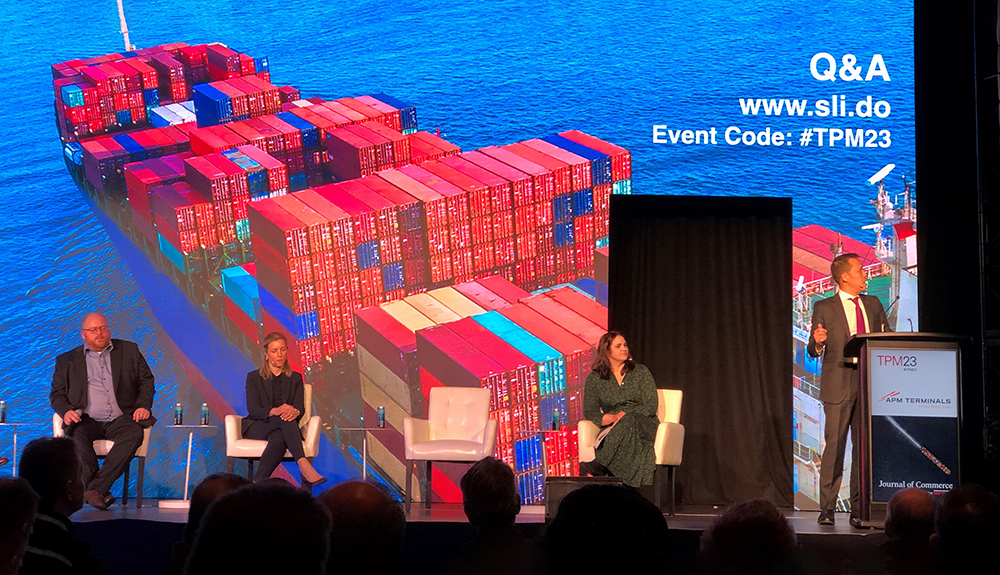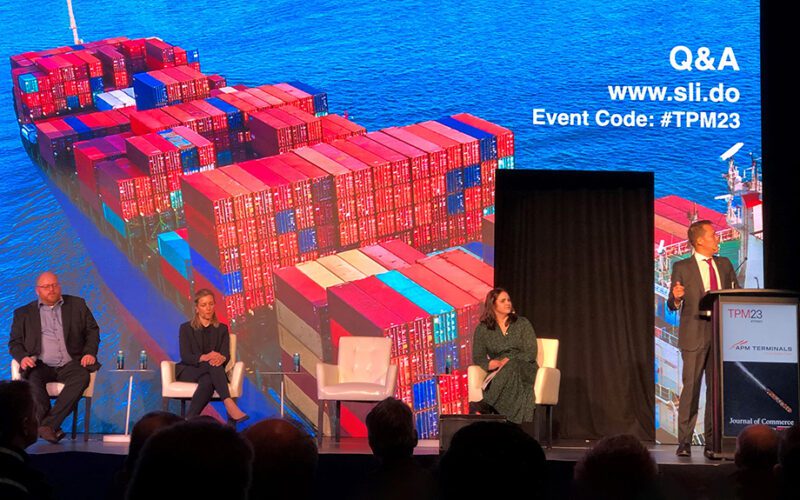
Congestion may finally be clearing at seaports and spot and contract rates may be returning to pre-pandemic levels, but some uncertainty remains for the shipping industry as potential challenges loom, panelists said at a Feb. 27 session at the TPM23 and TPMTech Conference by S&P Global Market Intelligence in Long Beach, Calif.
At the session “Container Shipping Outlook: Suddenly and Yet Again, It’s a New World,” panelists reflected on the rollercoaster of the last two years and gave their thoughts on what the new normal could bring.
The panel included Wan Hai Lines Vice Chairman Randy Chen, Barclays’ Director, Equity Research/European Transport, Alexia Dogani, Sea-Intelligence Consulting co-Founder and CEO Alan Murphy and CV International Vice President, Pricing and Procurement Rachel Shames.
Two years ago, the industry contended with the closure of Chinese factories and very little container traffic in the market at the lowest point of the pandemic.
The industry saw massive volume loss in the first half of 2020 and carriers responded by canceling up to 50% of individual weekly sailings, Murphy said.
Then an explosion of consumer demand resulted in ships at sea waiting to unload record cargo volumes and capacity that was so scarce that shippers resorted to alternative measures such as chartering vessels and using air freight to get the job done.
Chen spoke about how ocean carriers put previously offline vessels back into the market and started pulling vessels from other markets to meet demand in the Transpacific.
“Once the transit time started doubling from 49 days, from 56 days to 120 days, once we had 100 ships sitting out in San Pedro Bay, the only way to provide more capacity in the market, the only way to fill your orders and fulfill your logical requirements was to again just put more ships into the system,” Chen said. “And to be honest, we broke the system.”
Are we back to normal? Not quite, said Murphy, adding that he expects ocean carriers to use blank sailings as a tool to manage capacity.
“So, you might have low rates, (but) you’ve got horrible schedulability, you’ve got a massive loss of stability because of all these blank sailings,” he said.
Chen said he anticipates a move toward a more normal market for 2023.
“Maybe a normal market means that scheduled reliability is at 70%,” Chen said. “That’s not ideal, I admit that, but what is a normal market? A normal market is something where you have predictable capacity week in, week out. A normal market is where we’re not pulling ships from all kinds of different trades (to serve) … the most lucrative trade that we’ve seen in decades.”
But that doesn’t help medium-to long-term prospects, whether it’s planning vessel sailings or long-term capital expenditures, Chen said.
Meanwhile, the industry needed a breather, he said.
“The breather is what worked that congestion out, and as a result, we should be heading toward predictable capacity,” Chen said.
Heading Toward Normalization
Dogani of Barclays said the market is heading toward normalization, but how the industry gets there is slightly less certain.
“And at the moment, the main focus investors ask is, ‘What does this significant capacity situation mean?’” she said. “Very simply, we are in a period or entering a period of oversupply.”
Global sea trade volumes are tracking close to 3% below 2019 levels. In 2023, there will be 20% more capacity than 2019, Dogani said.
“So clearly there’s a very wide gap, and of course, capacity management could be an element, just how the spread closes again, but it will require action from the shipping lines,” she said.
Shames said there is still a lot of uncertainty among shippers about volumes and their contracts as they look toward this next year.
“There’s a lot of mixed messaging on the economy; we all see the news every day and there’s a different indicator every day,” she said.
Questions remain, Shames said. When are higher inventories coming down? How will consumers behave this year? Will there be a traditional peak season again, similar to pre-pandemic numbers?
An unresolved labor contract between West Coast dockworkers and their employers adds to the uncertainty, Shames added.
“This is definitely on the minds of a lot of shippers,” she said, adding that much of the freight is already shifting to the East Coast and Gulf Coasts to avoid any work disruption.
“And of course, we’re seeing a lot of investment in warehouses and distribution centers there,” Shames said of the East and Gulf Coasts, adding that those gateways have improved. “Certainly, some of that volume won’t come back.”
Shames added that “I think shippers are … used to unreliability, but also kind of tired of it and they’ll take … a little bit longer transit if they know that … there’s not going to be disruption like you would see it potentially in the West Coast.”
In the freight contracting world, freight buyers certainly have their leverage back, but with many newer risks now, Shames said.
Day-to-day service challenges could affect shippers and forwarders, from services shifting to digital platforms to the difficulty of getting information from steamship lines in a timely manne. There’s also the fear of sailings getting blanked or canceled entirely at the last minute, Shames said.
“It’s really difficult (for them) to plan their supply chain,” she said.
Shames said there’s optimism in the shipper community about the Ocean Shipping Reform Act, with anticipation of more transparency on issues such as invoicing, detention and demurrage disputes, diversification and sourcing.
Swings in the market have created a lack of confidence in contracts, Shames said, with terms and rates frequently renegotiated or unenforced.
“There are grievances on both sides, to be sure. It feels like we’re in a period where there’s just constant negotiation, certainly in the last year,” she said.
In the last few years, new models have emerged to address some of those issues, including different levels of accountability and different contract terms and penalties on both sides, whether it’s shippers or carriers not providing the agreed-upon volume or space.
Creative contract options could include making rate adjustments on a monthly or quarterly basis, as opposed to one fixed rate for the entire year, to help deal with the fluctuating market, while offering consistency and confidence that shippers are going to get space, Shames said.
“The good news is shippers are open to these solutions, which is great,” she said. “I think these are healthy, positive developments. But where the market is now, right, it’s really all about rates. Rates (are) king again. And so, we’ll see if these newer approaches have the same power.”
KAREN ROBES MEEKS, a Southern California native, is an award-winning journalist with more than 20 years’ writing experience. Her articles have appeared in the Los Angeles Times, San Francisco Chronicle, Orange County Register and Long Beach Press-Telegram, where she worked as a reporter for nearly 14 years. Her work has been recognized by the California News Publishers Association, the Associated Press News Executives Council and the Los Angeles Press Club. Karen can be reached at karen@maritimepublishing.com.

